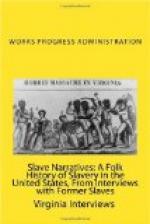“There was a young man and his wife and they worked fer some white folks. They had jest married and wuz trying ter save some money ter buy a home with. All at onct the young man went blind and it almost run him and his wife crazy cause they didn’t know what in the world ter do. Well, somebody told him and her about Mrs. Hirshpath, so they went ter see her. One day, says Mrs. Hirshpath, a big fine carriage drew up in front of her door and the coachman helped him to her door. She asked him who sent him and he told her. She only charged 50c for giving advice and after you wuz cured it wuz up ter you to give her what you wanted to. Well, this man gave her 50c and she talked ter him. She says, boy, you go home and don’t you put that cap on no more. What cap? he says. That cap you wears ter clean up the stables with, cause somebody done dressed that cap fer you, and every time you perspire and it run down ter your eyes it makes you blind. You jest get that cap and bring it ter me. I’ll fix ’em; they’s trying ter make you blind, but I go let you see. The boy was overjoyed, and sho nuff he went back and brought her that cap, and it wuzn’t long fore he could see good as you and me. He brought that ’oman $50, but she wouldn’t take but $25 and give the other $25 back ter him.
“What I done told you is the trufe, every word of it; I know some other things that happened but you come back anudder day fer that.”
PLANTATION LIFE
Georgia Baker, Age 87 369 Meigs Street Athens, Georgia
Written by:
Mrs. Sadie B. Hornsby [HW: (White)]
Athens
Edited by:
Mrs. Sarah H. Hall
Athens
and
John N. Booth
Dist. Supvr.
Federal Writers’ Project
Residencies 6 & 7
Augusta, Ga.
August 4, 1938
Georgia’s address proved to be the home of her daughter, Ida Baker. The clean-swept walks of the small yard were brightened by borders of gay colored zinnias and marigolds in front of the drab looking two-story, frame house. “Come in,” answered Ida, in response to a knock at the front door. “Yessum, Mammy’s here. Go right in dat dere room and you’ll find her.”
Standing by the fireplace of the next room was a thin, very black woman engaged in lighting her pipe. A green checked gingham apron partially covered her faded blue frock over which she wore a black shirtwaist fastened together with “safety first” pins. A white cloth, tied turban fashion about her head, and gray cotton hose worn with black and white slippers that were run down at the heels, completed her costume.
“Good mornin’. Yessum, dis here’s Georgia,” was her greeting. “Let’s go in dar whar Ida is so us can set down. I don’t know what you come for, but I guess I’ll soon find out.”
Georgia was eager to talk but her articulation had been impaired by a paralytic stroke and at times it was difficult to understand her jumble of words. After observance of the amenities; comments on the weather, health and such subjects, she began:




